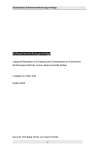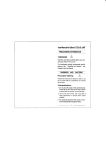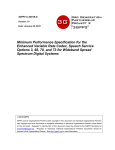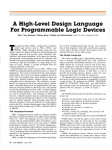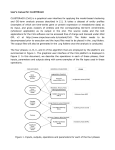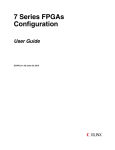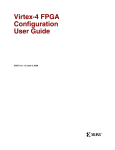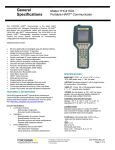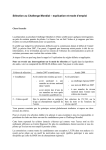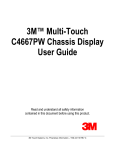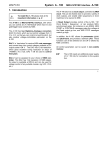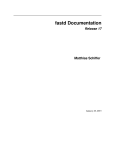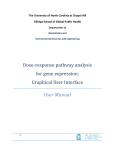Download Calculation of Critical Values for Somerville`s FDR Procedures
Transcript
JSS Journal of Statistical Software October 2007, Volume 21, Issue 6. http://www.jstatsoft.org/ Calculation of Critical Values for Somerville’s FDR Procedures Paul N. Somerville University of Central Florida Abstract A Fortran 95 program has been written to calculate critical values for the step-up and step-down FDR procedures developed by Somerville (2004). The program allows for arbitrary selection of number of hypotheses, FDR rate, one- or two-sided hypotheses, common correlation coefficient of the test statistics and degrees of freedom. An MCV (minimum critical value) may be specified, or the program will calculate a specified number of critical values or steps in an FDR procedure. The program can also be used to efficiently ascertain an upper bound to the number of hypotheses which the procedure will reject, given either the values of the test statistics, or their p values. Limiting the number of steps in an FDR procedure can be used to control the number or proportion of false discoveries (Somerville and Hemmelmann 2007). Using the program to calculate the largest critical values makes possible efficient use of the FDR procedures for very large numbers of hypotheses. Keywords: FDR, critical values, Fortran, Somerville’s procedure. 1. Introduction Recent developments in diverse fields, including genomics, have resulted in very large data sets where it may be desired to simultaneously test many thousands of null hypotheses. Traditional procedure to control the probability of rejecting true hypotheses in multiple hypotheses testing has been to control the family-wise error rate (FWER). For a large number of hypotheses, however, extremely low power for testing single hypotheses may result. Recently, procedures have been proposed which control the false discovery rate (FDR). The false discovery rate is defined to be the expected value of the proportion of rejected hypotheses which are actually true, with the false discovery rate defined to be zero when no hypotheses are rejected. Using an FDR procedure, the hypotheses H1 , H2 , . . . , Hm , are simultaneously tested using the corresponding test statistics t1 , t2 , . . . , tm . Let T(1) ≤ T(2) ≤ . . . ≤ T(m) be 2 Calculation of Critical Values for Somerville’s FDR Procedures the ordered test statistic values, and denote by H(i) the hypotheses corresponding to T(i) . Then critical constants d1 ≤ d2 ≤ . . . ≤ dm , are used to compare T(i) with di . For a step-down FDR procedure, for i = m, m − 1, . . ., compare T(i) with di until for the first time T(i) < di , rejecting in turn all the hypotheses for which T(i) ≥ di . For a step-up FDR procedure, for i = 1, 2, . . . , compare T(i) with di until for the first time T(i) ≥ di , rejecting all the hypotheses, except those for which the comparisons already made have shown T(i) ≤ di . The critical values di are chosen such that the expected value of the FDR is always less than some value q (or α). FDR procedures may also be defined in terms of critical p values. Benjamini and Hochberg (1995) proposed an FDR step-up procedure valid for independent test statistics. Benjamini and Lui (1999) presented a step-down FDR procedure valid under the same conditions. Sarkar (2002) showed that both procedures were valid under positive dependency. Troendle (2000) developed both step-up and step-down FDR procedures which asymptotically control the FDR when the test statistics have a multivariate t distribution. Somerville (2004), assuming a multivariate t distribution and common correlation of the test statistics used least favorable configurations to develop step-down and step-up FDR procedures. His step-down procedure yielded the same critical values as those of Troendle. It should be stated that, although extensive calculations strongly suggested the validity of the assumed location of the least favorable locations, a rigorous proof was not realized. Also, instead of setting negative critical values equal to zero, Somerville used a minimum critical value (MCV). The step-down FDR procedures of Troendle and Somerville have been shown by Horn and Dunnett (2004) and Somerville (2003) to have superior power, under the assumption that the test statistics have a multivariate t distribution. While FDR procedures control the expected value of the proportion of true hypotheses which are rejected, it is possible that a very large number of true hypotheses could be rejected. To control the number of true hypotheses, which are falsely rejected, van der Laan, Dudoit, and Pollard (2004) proposed the generalized family-wise error rate gFWER(k). It is defined as the probability of at least (k +1) Type 1 errors (k = 0 for the usual FWER), i.e. P[U ≤ k] ≥ 1−α where U is the number of true hypotheses which are rejected. Augmentation procedures proposed by van der Laan et al. (2004) and Dudoit, van der Laan, and Birkner (2004) can then be used to control PFP (proportion of false positives), where P[PFP ≤ γ] ≥ 1−α for some pre-specified γ and α . More recently Lehmann and Romano (2005) suggested new methods of controlling gFWER(k) (called by them k-FWER) and PFP (called by them FDP - False Discovery Proportion). Both single-step and step-down procedures were derived which control the k-FWER. The procedures make no assumptions concerning the dependence structure or the p values of the individual tests. The step-down procedure is simple to apply, and cannot be improved without violation of control of the k-FWER. Lehmann and Romano (2005) also proposed two methods for controlling the PFP. The first holds under “mild conditions on the dependence structure of p values” while the second requires no dependence assumptions. Somerville (2004) noticed that by limiting the number of steps in his procedures, the FDR could be reduced with a small subsequent loss of power. (An s step procedure is equivalent to an m step procedure where the m − s smallest critical values are replaced with the value dm−s+1 , also called MCV. Thus, only the largest s critical values are used in the comparisons). Somerville and Hemmelmann (2007), by limiting the maximum number of steps in stepdown and step-up procedures, developed new procedures to control k-FWER. The procedures require only an arbitrary set of critical constants d1 ≤ d2 ≤ . . . ≤ dm , and need not be related to any step-down or step-up procedure. However, by starting with a set of critical values Journal of Statistical Software 3 which satisfy an FDR requirement, the procedures can be used to simultaneously control FDR and k-FWER requirements. Using data from the literature, the method of Somerville and Hemmelmann (2007) was compared with those of Lehmann and Romano (2005), and under the assumption of multivariate normality and a common correlation of the test statistics, considerable improvement in the reduction of false positives, in control of PFP, and in power, were accomplished while still controlling the FDR. The Fortran 95 program seq.f95 can be used in four different modes to calculate the critical values for the procedure of Somerville (2004). In mode 1, the program calculates the critical values for step-down or step-up FDR procedures for one- or two-sided hypotheses, arbitrary degrees of freedom, arbitrary FDR levels and arbitrary common correlation coefficients. Using mode 3, the program calculates the largest critical values (number of critical values is specified by the user). Using mode 4, the Fortran 95 program, given the test statistic values, efficiently calculates an upper bound to the number of hypotheses which will be rejected. Given p values for the test statistics, the program, using mode 5, converts the p values to test statistic values and also obtains an upper bound to the number of rejected hypotheses. This paper has a number of objectives: 1. Describe the ways in which the Fortran program seq can be used in hypotheses testing, when the number of hypotheses is large. 2. Describe how the program obtains the constants used in Somerville’s FDR procedures. 3. Present instructions and examples, which make it relatively easy for a user, using the Fortran program seq to solve many hypotheses testing problems involving a large number of hypotheses. 2. Calculation of critical values The procedure for calculating the critical values is described in Somerville (2004). Let H1 , H2 , . . . , Hm be m hypotheses to be simultaneously tested using the test statistics T1 , T2 , . . . , Tm . We require that the false discovery rate (FDR), be less than a pre-specified value q (or α). If Q is the proportion of rejected hypotheses which are true, then FDR = E(Q). We wish to calculate the m critical values d1 ≤ d2 ≤ . . . ≤ dm , such that E(Q) ≤ q. We outline here the procedure for the step-down case. Let Ai be the probability that exactly i hypotheses are rejected. Then A0 = P[T(m) < dm ] A1 = P[T(m) ≥ dm , T(m−1) < dm−1 ] ... Am−1 = P[T(m) ≥ dm , . . . , T(2) ≥ d2 , T(1) < d1 ] Am = P[T(m) ≥ dm , . . . , T(2) ≥ d2 , T(1) ≥ d1 ] where T(1) ≤ T(2) ≤ . . . ≤ T(m) . To obtain the critical values, use is made of m least favorable configurations of the location parameters of the test statistics. Define LFC i as the configuration where i of the location parameters are zero and the remainder are infinite. (The case where all m hypotheses are true corresponds to LFC m ). To obtain d1 , use LFC 1 . Then, with probability 1, T(m) , . . . , T(2) are infinite, and A0 , . . . , Am−2 are zero, and E(Q) = Am−1 (0/(m − 1)) + Am (1/m) ≤ q or P[T(1) ≥ d1 ] ≤ mq. 4 Calculation of Critical Values for Somerville’s FDR Procedures To maximize power considerations, we choose the smallest value di which satisfies the equation. To obtain di , (1 < i ≤ m), given the values of d1 , . . . , di−1 , use LFC i . With probability 1, T(m) , T(m−1) , . . . , T(i+1) are infinite and A0 , . . . , Am−i−1 are zero. Under LFC i , when exactly r(≥ m − i) hypotheses are rejected, the proportion of true hypotheses rejected equals (r − (m − i)/r) with probability 1. We may then write, using the basic expectation algorithm, E(Q) = Am−i (0/(m − i)) + Am−i+1 (1/(m − i + 1)) + . . . + Am (i/m) where A(m−i+1) = P[T(i) ≥ di , T(i−1) < d(i−1) ]1 ... Am−1 = P[T(i) ≥ di , . . . , T(2) ≥ d2 , T(1) < d1 ] Am = P[T(i) ≥ di , · · · , T(2) ≥ d2 , T(1) ≥ d1 ]. Since Am−i+1 , . . . , Am are each decreasing functions of di , we choose di as the smallest value such that E(Q) ≤ q. The value for dm for the FDR step-down procedure may also be calculated using the equation P[T(m) < dm ] = 1−q. For the FDR step-up procedure, the formula slightly underestimates dm . 3. Fortran 95 implementation 3.1. Mode 1 The program first calculates d1 and dm . The problem is to find the smallest value for di given previously obtained values d1 , . . . , di−1 , subject to FDR = E(Q) ≤ q. Since d1 ≤ d2 ≤ . . . ≤ dm , starting lower and upper bounds, boundXL and boundXU, for di are di−1 and dm . (It is well known that dm for the step-up case is never less than dm for the step-down case for the same parameter values. Extensive calculations suggest that the ratio is never greater than approximately 1.01, with the values close to 1.0 for large values of m. For step-up FDR, the upper bound for dm is “conservatively” replaced with 1.1 times the values of dm for the stepdown case.) Starting “attained” lower and upper bounds, boundFL and boundFU, for FDR are set at 0 and 1. Two initial estimates of di , x1 and x2 are chosen to calculate the corresponding values of FDR, namely F1 and F2 . (The subroutines getFDR and getFDRup are used to obtain the corresponding FDR values.) Using those calculations, the subroutine bound(X,F) is used to improve both sets of bounds. Linear interpolation is then used to obtain a third estimate x3 (modified, if necessary, to keep it within the existing bounds), and the corresponding FDR value F3 calculated. If F1 is closer to q than F2 , then the values x2 and F2 are replaced with the values x3 and F3 , and likewise the values x3 and F3 replace the values x1 and F1 if F2 is closer. Again linear interpolation using the new pair, x1 and x2 is used to obtain a new x3 and the iteration continues until the process is defined to converge. The program attempts to obtain an estimate for di with an FDR within .0001 of q. Subroutine getFDR The subroutine getFDR (getFDRup for the step-up case) uses Monte Carlo to get estimates for Am−i+1 to Am (step-down case) given the previously obtained values d1 , . . . , di−1 and an 1 Somerville (2004), page 102 line 18, gives an erroneous formula for Am−i+1 . Journal of Statistical Software 5 estimate for di . The estimate of Aj is the proportion of the n vectors, whose elements are the randomly obtained values for the m test statistics, for which the FDR procedure rejects exactly j hypotheses under LFC i . The FDR is then obtained as E(Q) = Am−i (0/(m − i)) + Am−i+1 (1/(m − i + 1)) + . . . + Am (i/m). Subroutine bound(X,L) The subroutine bound(X,L) replaces boundXU with xi and boundFL with FDRi if boundFL < Fi < q, and replaces boundXL with xi , and boundFU with F DRi if q < Fi < boundFU. 3.2. Mode 3 In mode 3, the program calculates the pre-specified “ic”“unique” values (number of steps s). The values d1 , . . . , dm−ic+1 are equal and trial values x1 and x2 are chosen to calculate the corresponding FDR values F1 and F2 . As in mode 1, linear interpolation is used to obtain x3 and iteration is employed to obtain the common value of the m−ic+1 smallest critical values. seq.f95 uses the procedures of mode 1 to calculate the remaining ic − 1 critical values. 3.3. Mode 4 Calculating all of the critical values for Somerville’s FDR procedure would present an almost insurmountable task when the number of hypotheses to be simultaneously tested is very large. The object of mode 4 is, given the values of all of the test statistics (or their p values), is to estimate an upper bound to the number of hypotheses that the procedure would reject. Having this upper bound, a user could use an s-step version of the procedure. (The value of s would be equal to the upper bound). This would require the calculation of only s critical values, which should then present a manageable task. The program is designed so that using mode 4 estimates both an upper bound to the number of test statistics to be rejected, and also calculates the needed s critical values for a corresponding s-step procedure. Starting with i = 1, the program assumes that MCV equals the ith largest test statistic and estimates the probability that at least i test statistics will each be greater than or equal to MCV. The program finds the largest value of i (ub) such that the probability is less than or equal to q. Mode 3 can be used to calculate the largest s (= ub) critical values. The values of nCV and nCVend in line 2 are not used in the program. For a quick estimate, the value of n need not be large, with n = 1000 usually adequate. 3.4. Mode 5 seq.f95 converts the p values to test statistic values and mode 4 is used. 4. Errors in the estimates The iterative procedure is complicated by the fact that the FDR calculations are Monte Carlo based. To reduce the effect of such errors, the same random number seeds are used for each FDR calculation. p For fixed critical values, the error in the calculated value of FDR can be approximated by (FDR(1 − FDR)/n). Numerous calculation to estimate the partial 6 Calculation of Critical Values for Somerville’s FDR Procedures Figure 1: Effect of n on accuracies of critical value calculations derivative of dj with respect to FDR indicate that for a change of in FDR, changes in the value of dj from 7 to 40 may be required and the change in dj is a function of m, q, and the value of j. The fortunate aspect is that modest errors in the estimation of a critical value may result in much smaller errors in the achieved False Discovery Rate. Since calculation of each critical value is a function of all previously calculated critical values, there is also a self-correcting effect, which may be enhanced by smoothing the final set of critical values. Values of n greater than 10,000 are recommended when calculating critical values. Figure 1 illustrates the effect on the accuracy of the critical values as n increases. Values used are step-down FDR, 1-sided hypotheses with m = 1000, ρ = 0, q = .05, and four values for n, namely 103 , 104 , 105 and 106 , and using exactly 31 “unique” critical values. 5. Examples The program was used in mode 4 to obtain an upper bound to the number of rejected hypotheses for the data of Hedenfalk et al. (2001). Using n = 10, 000 or 100, 000, q = .05, ρ = 0, df = ∞, 2-sided hypotheses, seq.f95 has given an upper bound to the number of hypotheses to be rejected as 153. An example for each of the four modes is given. The input file crit.in is given for each, as are the two output files crit.out and seq.out. 6. Summary and conclusions Using the program seq.f95 to obtain a specified limited number of critical values for the FDR procedure is simple and efficient and the results can be used to control the number Journal of Statistical Software 7 and proportion of false positives. The FDR procedure requires that the test statistics have a multivariate t distribution with a common correlation. Limited studies suggest that the procedure has robust qualities with regard to the assumption of the multivariate t distribution, and is conservative when correlations are underestimated. It is not difficult to show that d1 and dm , the smallest and largest critical values are decreasing functions of ρ, the common correlation coefficient. Acknowledgments The author is indebted to the referees for helpful comments and suggestions. References Benjamini Y, Hochberg Y (1995). “Controlling the False Discovery Rate, a Practical and Powerful Approach to Multiple Testing.” Journal of the Royal Statistical Society B, 57, 289–300. Benjamini Y, Lui W (1999). “A Step-down Multiple Hypotheses Testing Procedure that Controls the False Discovery Rate under Independence.” Journal of Statistical Planning and Inference, 82, 163–170. Dudoit S, van der Laan MJ, Birkner MD (2004). “Multiple Testing Procedures for Controlling Tail Probability Error Rates.” Working Paper 166, University of California, Berkeley, Division of Biostatistics, Working Paper Series. URL http://www.bepress.com/ucbbiostat/ paper166/. Hedenfalk I, et al. (2001). “Gene Expression Profiles in Hereditary Breast Cancer.” The New England Journal of Medicine, 344, 539–548. Horn M, Dunnett CW (2004). “Power and Sample Size Comparisons of Stepwise FWE and FDR Controlling Test Procedures in the Normal Many-One Case.” In “Lecture Notes Monograph Series,” volume 47, pp. 48–64. Institute of Mathematical Statistics. Lehmann EL, Romano JP (2005). “Generalizations of the Familywise Error Rate.” The Annals of Statistics, 29, 1138–1154. Sarkar SK (2002). “Some Results on False Discovery Rate in Stepwise Multiple Testing.” The Annals of Statistics, 30, 239–257. Somerville PN (2003). “Optimum FDR Procedures and MCV Values.” Technical Report TR-03-01, Department of Statistics, University of Central Florida. Somerville PN (2004). “FDR Step-down and Step-up Procedures for the Correlated Case.” In “Lecture Notes Monograph Series,” volume 47, pp. 100–118. Institute of Mathematical Statistics. Somerville PN, Hemmelmann C (2007). “Step-up and Step-down Procedures Controlling the Number and Proportion of False Positives.” Computational Statistics & Data Analysis, 51. 8 Calculation of Critical Values for Somerville’s FDR Procedures Troendle JF (2000). “Stepwise Normal Theory Multiple Test Procedures Controlling the False Discovery Rate.” Journal of Statistical Planning and Inference, 84, 139–158. van der Laan MJ, Dudoit S, Pollard KS (2004). “Augmentation Procedures for Control of the Generalized Familywise Error Rate and Tail Probabilities for the Proportion of False Positives.” Statistical Applications in Genetics and Molecular Biology, 3, 1–25. Journal of Statistical Software 9 A. User manual A.1. Capabilities of the program Some of the capabilities are: • The program can be used to calculate all or a specified number of the largest critical values needed to simultaneously test m null hypotheses. The hypotheses may all be one-sided or all two-sided. • If all of the values of the test statistics (or all of the p values) are available, the program can be used to estimate an upper bound to the number of hypotheses which will be rejected, and a corresponding MCV will be given. The program can then be used to calculate that number of critical values or the user can specify the MCV. This is an especially useful capability of the program, and eliminates the practically insurmountable task of calculating all of the m critical values when m is very large. • A minimum critical value (MCV) can be specified. That is, the user decides that a hypothesis will never be rejected if the test statistic value is less than MCV. The program will then calculate all of the necessary critical values. • Enables user to calculate critical values for an implementation of the procedure of Somerville and Hemmelmann (2007) (controlling the number of false positives, given a set of critical values). In all cases, the user will need to specify all of the following parameters: m the number of hypotheses, df the common number of degrees of freedom for all of the test statistics (or p values), q the false discovery rate (also often denoted by α), upordown for step-down, a negative integer, for step-up, a positive integer or zero, nbrsided 1 for one-sided hypotheses, 2 for two-sided hypotheses, rho common correlation between the test statistics. In addition, the user will need to specify values for iseed, n, nCV and nCVend: iseed a positive integer for the random number generator, e.g., 757. n the number of random m-dimensional vector to be generated. The size of n determines the accuracy of the critical values generated. A value less than 10,000 is almost never recommended. A value of 1,000,000 will usually be sufficient to produce near 3 decimal accuracy. nCV, nCVend dnCV is the first value and dnCV is the last value to be calculated. It is assumed that the values d1 to dnCV −1 have already been calculated. Note: if the mode is not 1, arbitrary values for nCV and nCVend may be input. 10 Calculation of Critical Values for Somerville’s FDR Procedures Three files must exist prior to the running of the program. crit.in consists of three lines and contains the necessary input for the program. The two files crit.out and seq.out will contain the output of the program at the completion of running the program seq.f95. The program has four modes: 1, 3, 4, and 5. Mode 1 In this mode, the program calculates all of the critical values from dnCV to dnCV end . It is assumed that the values from d1 to dnCV −1 are known. If all of the critical values are to be calculated, set nCV = 1, and set nCVend = m. This mode can also be used when an MCV is given. Set nCV = 2 and nCVend = m, and in line 3, make both the first and second values equal to MCV. This could be very inefficient if m is large unless a small value of n can be used. If one is able to make a close underestimate of the number critical values which will be equal to MCV (say ub), then setting nCV equal to ub and nCVend equal to m, and inserting ub consecutive values of MCV in line 3 of crit.in will be much more efficient. A method to make an estimate of ub might be to make several runs using guessed values for ub, using a smaller value for n (say 1000). See also the note in Mode 3. Mode 3 This mode is used when only the largest critical values need to be calculated. (See modes 4 and 5.) When using mode 3, the values for nCV and nCVend are ignored. If ub is the number of critical values to be calculated, line 3 should contain only the value ub. Note: The smallest critical value for an s-step procedure is also the MCV for the procedure. Mode 4 If the set of m test statistic values are given, the program efficiently calculates an upper bound (say ub) to the number of hypotheses that will be rejected, and a corresponding MCV. Mode 3 can then be used to calculate only the largest ub critical values. The remaining critical values can then be set equal to the smallest of the calculated critical values, constituting the set of critical values needed for an s-step FDR procedure. Mode 5 Given the p values corresponding to the m hypotheses, the p values are converted to test statistic values, and the methodology used in mode 4 is used to determine an upper bound to the number of hypotheses which will be rejected. Contents of the input file crit.in crit.in contains three lines. The first line contains the digit 1, 3, 4 or 5, corresponding to the desired mode. The second line contains ten elements: n, iseed, m, nCV, nCVend, df, q, nbrsided, upordown, rho. Note that unless the mode is 1, arbitrary integers may be used for nCV and nCVend. If the mode is 1, the third line contains the previously obtained values for d1 to dnCV −1 , followed by an estimate for dnCV . If no values have been previously obtained, the line contains Journal of Statistical Software 11 an estimate for d1 . If the mode is 3, the line contains only the integer giving the number of critical values to be obtained. If the mode is 4 or 5, the line contains exactly m values. If the mode is 4, the elements are the values of the test statistics (in non-decreasing order). If the mode is 5, the elements are the p values corresponding to the hypotheses (in non-increasing order). Contents of the output file seq.out If the mode was 1 or 3, seq.out contains the requested calculated critical values and their critical value number nCV. If the mode is 4 or 5, seq.out gives an upper bound to the number of hypotheses that may be rejected (say ub). It gives also the ub-th largest test statistic which is also a corresponding MCV. Contents of the output file crit.out This file contains some of the results of intermediate calculations. It may be of interest to some users. A.2. Calculating all of the critical values If 20 hypotheses to be simultaneously tested with the expected value of the FDR to be controlled at the level .05, the hypotheses are all two-sided, the degrees of freedom for each of the test statistics is 19, and the test statistics have a common correlation of zero. For step-down FDR, the following 3 lines in crit.in can be used: 1 10000 757 20 1 20 19 .05 2 -3 0.0 1.024 (This number is your estimate of the value of d1 and could be set equal to zero.) See also Example 4.1 in seq.f95. A.3. Determining an upper bound for the number of rejected hypotheses Suppose the values of the test statistics are as follows (arranged in non-descending order of magnitude): 0.74 1.01 1.30 1.42 1.42 1.50 1.60 1.73 1.82 1.82 1.95 2.04 2.42 2.61 3.02 3.15 4.02 4.32 5.12 5.23 With the expected value of FDR to be controlled at the level .05, two-sided hypotheses, 19 degrees of freedom and a common correlation of zero and step-down FDR, the following 3 lines in crit.in can be used: 4 10000 757 20 17 20 19 .05 2 -3 0.0 0.74 1.01 1.30 1.42 1.42 1.50 1.60 1.73 1.82 1.82 1.95 2.04 2.42 2.61 3.02 3.15 4.02 4.32 5.12 5.23 12 Calculation of Critical Values for Somerville’s FDR Procedures The program will then give 8 hypotheses as the upper bound (corresponding to an MCV of 2.42). See also Example 4.3 in seq.f95. Using the p values corresponding to the above test statistic values, the following 3 lines can be used in crit.in: 5 10000 757 20 17 20 19 .05 2 -3 0.0 0.468346 0.325186 0.209152 0.171809 0.171809 0.150049 0.126095 0.099842 0.084551 0.084551 0.066089 0.055499 0.025711 0.017214 0.007043 0.005273 0.000732 0.000369 0.000061 0.000048 A.4. Calculating the s largest critical values For m = 1000, I would like to calculate the 10 largest critical value (use a 10-step procedure). I wish to use 2 sided FDR, assume a common correlation of 0.0. Each test statistic has 20 df. Arbitrary values may be given for nCV and nCVend. The following may be used as input for crit.in. 3 10000 757 1000 1 44 20 .05 2 -3 0.0 10 See also Example 4.2 in seq.f95. A.5. Specifying a minimum critical value For any set of parameters, m, rho, upordown, df, nbrsided, q there is a relationship between an MCV and the number of “unique” critical values (number of steps in the corresponding s-step procedure). Knowing the approximate relationship may assist in determining whether to use a “unique” number of critical values or choose an MCV. A quick way to explore this is to choose several numbers of “unique” critical values and find the corresponding MCVs. If m = 5000, df = 30, q = .05, rho = 0, and 1-sided step-down, choosing 20 “unique” values (a small value for n will be sufficient here, and values for nCV and nCVend are arbitrary), crit.in could be the following: 3 1000 757 5000 4 7 30 .05 1 -3 0.0 20 Note that after the program calculates the first critical value, the following statement occurs: MCV = 3.887 for exactly 20 "unique" critical values. Abort the program (using CTRL BREAK) and replace 20 in line 3 with another number, and repeat the process. Using Journal of Statistical Software 13 successively the values 10, 20, 40, 60, 80, 100, 500, one obtains corresponding MCV’s of 4.111, 3.887, 3.620, 3.501, 3.398, 3.316, 2.656. A.6. Implementing the procedure of Somerville and Hemmelmann Somerville and Hemmelmann (2007) have shown that the number of false discoveries can be controlled by limiting the number of steps in a step-down procedure. Suppose there are 5000 test statistics each with 22 df. A step-down procedure is desired such that the probability of more than 10 false discoveries is less than .05 (approximately). Using the FDR step-down procedure of Somerville (2004) what is the maximum number of steps that can be used? Assuming the test statistics have a multivariate t distribution with a common correlation of zero, the formulas for the number of steps given by Somerville and Hemmelmann (2007) and interpolation can be used. If k is the number of false discoveries: for df = 15: Max Steps = −0.24923 + 3.85682k − .000425084k 2 (use for k ≤ 33). for df = ∞ : Max Steps = −5.0138 + 10.1836k + 0.3642844k 2 (use for k ≤ 19). Using k = 10, the maximum number of steps would be 38.276 and 133.25 for df = 15 and df = ∞ , respectively. Using linear interpolation in 1/df , the number of steps for df = 22 would be 62.02. Similarly, for k = 19, the number of steps would be 134.65. That is, if U is the number of false discoveries: P[U ≤ 10] ≤ .05 if no more than 62 steps can be used. P[U ≤ 19] ≤ .05 if no more than 134 steps can be used. The program seq can be used to calculate the necessary critical values. For higher common correlations between the test statistics, the Fortran 95 program FDRPWR could be used to find the maximum number of steps that could be used and still meet the stated requirements. See Somerville and Hemmelmann (2007). A.7. Special conditions for step-up FDR Somerville (2004) noted that using his step-up FDR procedure, an MCV was sometimes necessary. Using seq for small values of m, even for large values for n, the following message may occur if an attempt is made to obtain all of the critical values: Unable to get large enough d value. Try larger values for n. For step-up FDR, a larger value of MCV may be required. A practical solution, and an efficient procedure, is to use mode 3, and obtain only the largest values (e.g. 20, 50 or 100). A.8. An additional capability when using modes 4 or 5 Examining the file seq.out, where the output for Example 4 (Hedenfalk data) is given, the following statement appears: As many as 153 hypotheses may be rejected (FDR level .05). It should be noted that, examining the FDR column, additional statements may be made: As many as 54 hypotheses may be rejected (FDR level .01). As many as 28 hypotheses may be rejected (FDR level .001). 14 Calculation of Critical Values for Somerville’s FDR Procedures Affiliation: Paul N. Somerville Department of Statistics and Actuarial Science University of Central Florida Orlando, Florida, United States of America E-mail: [email protected] URL: http://pegasus.cc.ucf.edu/~somervil/ Journal of Statistical Software published by the American Statistical Association Volume 21, Issue 6 October 2007 http://www.jstatsoft.org/ http://www.amstat.org/ Submitted: 2006-01-28 Accepted: 2007-04-11














